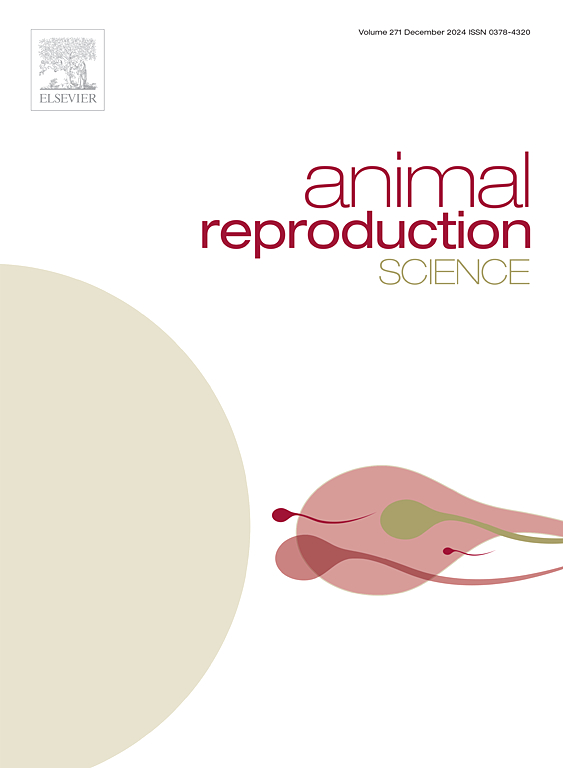AMPKα alleviates the inhibitory effect of NEFA on the function of bovine follicular granulosa cells cultured in vitro
IF 2.2
2区 农林科学
Q1 AGRICULTURE, DAIRY & ANIMAL SCIENCE
引用次数: 0
Abstract
High levels of non-esterified fatty acids (NEFA) in cows with subclinical ketosis (SCK) impair postpartum follicular development and disrupt estrus. The precise mechanism through which NEFA impacts the functionality of bovine follicular cells remains elusive. An in vivo experiment was conducted to compare SCK cows without estrus (SCK-E, n = 6) with healthy cows in estrus (C-E, n = 6). In the vitro test, bovine granulosa cells (GCs) were exposed to 0.4 mM NEFA. Notably, the SCK-E group exhibited an elevated ratio of phosphorylated adenosine 5’-monophosphate-activated protein kinase α (AMPKα) to total AMPKα in both liver and ovarian tissues, compared to the C-E group. NEFA treatment of GCs adversely affected steroid hormone synthesis, suppressed the expression of cyclin and proteins crucial for steroid synthesis, and triggered cell apoptosis, thereby inhibiting cell proliferation. Furthermore, it led to a decline in cell mitochondrial membrane potential and an increase in reactive oxygen species production, ultimately causing cellular damage. Subsequently, GCs were co-cultured with adenovirus (ad-AMPKα-siRNA) and NEFA (0.4 mM). Inhibiting AMPKα further exacerbated the detrimental effects of NEFA on steroid hormone synthesis, cell apoptosis, cell proliferation, and mitochondrial function in GCs. Furthermore, upon inhibiting AMPKα, a reduction was observed in both mRNA and protein levels of acetyl-CoA carboxylase 1, accompanied by an elevation in the levels of carnitine palmitoyltransferase-1. These findings suggest that AMPKα becomes activated in SCK cows experiencing elevated NEFA levels, and that AMPKα has the potential to mitigate the detrimental effects of NEFA on GCs function in vitro.
求助全文
约1分钟内获得全文
求助全文
来源期刊

Animal Reproduction Science
农林科学-奶制品与动物科学
CiteScore
4.50
自引率
9.10%
发文量
136
审稿时长
54 days
期刊介绍:
Animal Reproduction Science publishes results from studies relating to reproduction and fertility in animals. This includes both fundamental research and applied studies, including management practices that increase our understanding of the biology and manipulation of reproduction. Manuscripts should go into depth in the mechanisms involved in the research reported, rather than a give a mere description of findings. The focus is on animals that are useful to humans including food- and fibre-producing; companion/recreational; captive; and endangered species including zoo animals, but excluding laboratory animals unless the results of the study provide new information that impacts the basic understanding of the biology or manipulation of reproduction.
The journal''s scope includes the study of reproductive physiology and endocrinology, reproductive cycles, natural and artificial control of reproduction, preservation and use of gametes and embryos, pregnancy and parturition, infertility and sterility, diagnostic and therapeutic techniques.
The Editorial Board of Animal Reproduction Science has decided not to publish papers in which there is an exclusive examination of the in vitro development of oocytes and embryos; however, there will be consideration of papers that include in vitro studies where the source of the oocytes and/or development of the embryos beyond the blastocyst stage is part of the experimental design.
 求助内容:
求助内容: 应助结果提醒方式:
应助结果提醒方式:


